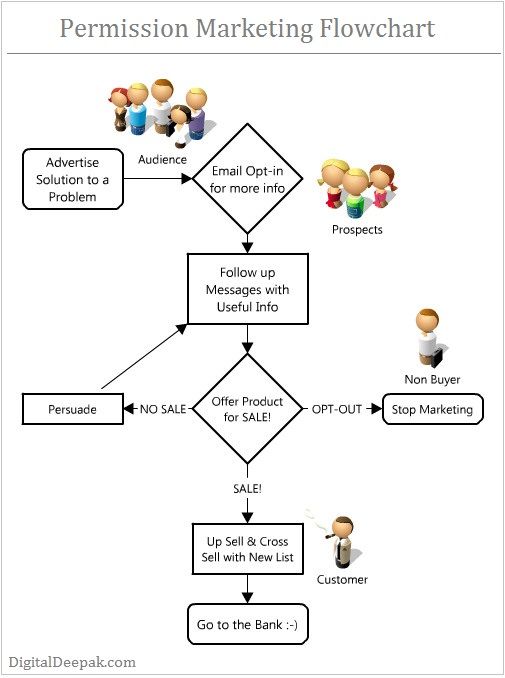What is Permission Marketing and How to Execute it Effectively

Marketing in one perspective is just communication – Communicating the availability and features of a product or service to potential customers. We encounter marketing messages every day. When you think about it, you would realize that most of the marketing messages are pushed to you and not requested by you. This is also termed as interruption marketing. TV ads, Newspaper Ads, Out door advertising, spam mail and so on are interruption marketing messages trying to get our attention while we carry on with our day.
For many companies this model works just fine. They out-spend the competition with the ads, they generate more sales and revenues and the cycle goes on. In certain cases, promotion of a product or service is not possible with the above method. A start up company who have come up with a new product or service do not have the marketing budget to out-spend the competition. Also the conversion rate on such marketing messages is extremely low because they are un-targeted. The marketing messages reaches a whole bunch of people who are not interested in the product or service.
Permission marketing is an evolution of direct marketing. You marketing your product or service to your potential customers with their permission. How is it possible? It is possible when they opt-in to receive information from you.
Permission marketing is asking for an audience about their interest in your product or service, let a certain percentage of the audience put their hands up expressing their interest in your offer and then you offer them further information. Before email became main stream this was still practiced using direct mail. But it was done only by a few people because it was difficult to manage sending out thousands of letters physically. Now email has made it far easier to do direct marketing electronically and permission marketing has reborn.

The above flow chart gives an idea about how the process has to be carried out. Each step is explained below:
Advertising a Solution
The first step is advertising. But you may ask: isn’t it interruption marketing? Yes it is… but just to get people interested in our offer and allow them to opt-in. For example instead of selling the product directly, you would have seen many ads with titles like “Learn how to ABC in 10 days” or “Are you having XYZ problem? Here’s a solution”. People who are not interested will not opt-in – they will ignore the ads. All the people who opt-in are potential customers. Usually opt-in is carried out using a landing page (or a squeeze page) which is just a single page with one goal: let the people sign up using their name and email address.
The first step of opt-in can also be carried out using inbound marketing instead of doing it with interruption advertising. You can publish articles in your blog, attract potential customers through quality content and let them opt-in to your subscriber list using various techniques. In one of my previous articles I have laid out 7 ways to capture people’s name and email address. This process is also called converting visitors into leads.
Follow Up Messages
Once potential customers have opted-in to receive more information, we should send them timely follow-up messages to convert them into customers. The follow up messages should be crafted in such a way that they have useful but incomplete. For complete information/solution they should be motivated to buy the product offering. Knowledge in copy writing, persuasion and sales psychology will be of great help while crafting these messages.
When the potential customer is motivated enough to buy the solution, we should present the product to them. Instead of pushing them to buy, this should be a soft sell. Many people will not be ready to buy right away and some will need more information and time to make a buying decision. People who have not bought the product are retained in the same mailing list and we should follow up with more messages (combination of useful messages and sales messages) until they opt-out. Some will end up buying the product and these customers should be segmented into a new list.
Up-Sells and Cross Sells
The usual saying goes like this: “It is 10 times easier to sell to an existing customer than to a new customer”. For many companies the major part of their revenues come from existing customers than new customers. Repeat customers are so valuable that some companies are even ready to lose money on the front end sales. Once prospects become customers, they should be removed from the prospects list and segmented into a new list. Such automation can be easily done with email marketing tools such as aweber.com, getresponse.com etc.
The general industry terms for this list is “Buyer’s List”. The people in this marketing list are proven to be buyers. Such a list also opens up opportunities for cross promotion of other products. Affiliate marketing can be done very easily with internet marketing and promoting affiliate offers to a highly targeted list of buyers is one of the most lucrative businesses around.
Integration With Content Marketing
Permission marketing can be integrated with content marketing. The email subscribers can be notified about new content on the blog and new email subscribers can be gained from the blog visitors who come from other sources than the email list. For more information read my blog article about integrated digital marketing.
Any questions?